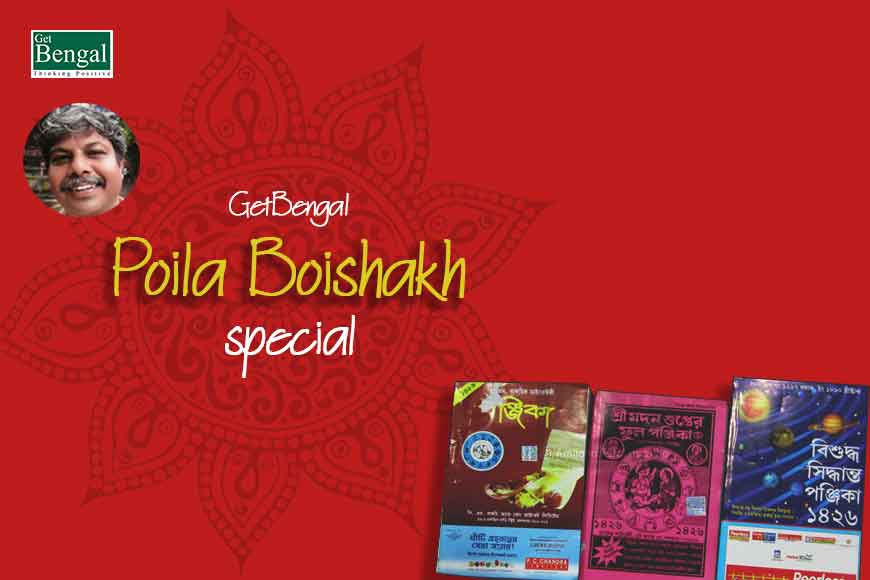The Bengali Panjika: A timeless tradition intrinsic to the Bengali New Year Celebrations—GetBengal story

Renowned Bengali humorist and litterateur Sri Shibram Chakraborty has immortalised the essence of New Year celebrations by pointing out that people’s enthusiasm for ushering in a new year is somewhat misplaced. He wittily observed that, historically, each new year has only managed to last for about a year!
Traditionally, Bengali New Year celebrations were centred around the Bengali calendar, but over time, English New Year celebrations have also become popular. Today, the New Year festivities encompass various communities, including micro-minorities like the Chinese in Kolkata, drawing participation from a diverse crowd.
A quintessential part of ushering in the New Year in the Bengali tradition is consulting the Bengali almanack, known as the Panjika. Although the word "Panjika" rhymes with "Ganjika," a local term for weed, the two are quite different. Reading through the pages of a Panjika can be addicting in its own way, evoking a sense of nostalgia for a simpler time when life was less complex and beliefs were unquestioned. The Panjika not only provides horoscopes (Rashifal) but also contains religious observations related to births, deaths, rice ceremonies, and thread ceremonies, among others.
The new Panjika is typically available in the market a few days before the Bengali New Year. Publishers like Gupta Press, PM Bagchi, and Benimadhab Seal claim that their publications are based on the ancient Surya Siddhanta treatise propounded by Raghunandan. On the other hand, Visuddha Siddhanta claims that their Panjika is based on the Government of India Panchang, following the Driksiddha calculations, which they consider scientific.
The word "Panjika" is often thought to be related to "Panchang," but according to Shabdakalpadruma, a Sanskrit thesaurus, "Panchang" originates from "Panch," while "Panjika" is derived from "Panji." While there may not be an etymological or grammatical connection, functionally, they are related, as the Panjika also provides information on five key aspects - Tithi, Nakshatra, Yoga, Karana, and Baar.
The evolution of the Bengali Panjika is intertwined with the history of the Bengali Year or Bangabda. Its origin is debated, with some historians attributing it to the reign of King Sansanka, while others credit Emperor Akbar's reforms. Akbar sought to address issues arising from the lunar calendar, which caused months to occur in different seasons, affecting agriculture and revenue collection. He enlisted the help of astronomer Amir Fathullah Shirazi to convert the lunar Hijri year to a solar year system.
Also read : A few Bengali calendar basics as we begin 1429
The exact origins of the Bengali Panjika are obscure, but it is believed that handwritten Panjikas were used in Bengal initially, primarily by aristocrats and royalty. Common people relied on simpler methods, such as tracking the timings of sunrise and sunset. The first printed Bengali Panjika, known as Nabadwip Panjika, was edited and published by Pandit Raghunandan Bhattacharya in the 16th century. Later, during the reign of Raja Krishnachandra of Nadia, scholars Ramrudra Vidyanidhi and Vishwambhar Jyotisharnab were entrusted with the responsibility, leading to the publication of the famous Gupta Press Panjika in 1869, making this vital source accessible to common Bengali Hindus.
Before mass publication, a special class of Brahmins known as Grahacharyas would visit households on the New Year to recite the annual horoscope, especially for elders or the karta of the family. They also provided astrology-related services throughout the year, including presiding over rituals and offering remedies for adverse planetary positions. However, with time, this practice has faded, and modern astrologers now offer similar services through television channels, presenting hope and aspiration in a more contemporary manner.
The modern Panjika features advertisements for astrologers and books, ranging from pulp fiction to epics like the Ramayana and Mahabharata. It includes sections on planetary positions, eclipses, and horoscopes for twelve months, starting from Boishakh and ending at Chaitra, as well as horoscopes for India, West Bengal, Assam, and Tripura. Additionally, it provides auspicious timings for various ceremonies, sunrise and sunset times, and prohibitions on eating certain vegetables at different times, among other things.
The Panjika, a traditional almanack in Bengali culture, begins with the enumeration of planets and includes the timings of solar and lunar eclipses. It then provides horoscopes for twelve months, starting with Baishakh and ending with Chaitra, as well as horoscopes for India, West Bengal, Assam, and Tripura. The section following this is particularly useful, as it enumerates auspicious timings for conducting various rites and ceremonies, such as marriage, thread ceremonies, starting construction, and planting saplings.
Interestingly, the Panjika does not consider Saraswati Puja as an auspicious event for the initiation of education for children, contrary to common practice. While old American almanacks included sections on humour, the Panjika has its own unique beliefs. For example, it describes the significance of a house gecko falling on different parts of the body, suggesting outcomes ranging from gaining royal pleasures to financial loss or even death.
The bulk of the Panjika lists daily timings for rituals, sunrises, sunsets, high and low tides, and various prohibitions. These prohibitions include restrictions on eating certain vegetables during different tithis and times to avoid starting a journey. Believers in this tradition often point out the underlying scientific reasons behind these practices.
Despite its adherence to old customs, the Panjika also attempts to modernise. Alongside listings of auspicious times for worship and ceremonies, modern Panjikas mention events like World Environment Day and advise pre-marriage medical checks to prevent genetic diseases. While some may find the Panjika outdated, it remains integral to the lives of millions throughout Bengal, providing a fascinating view of the evolution of society.











